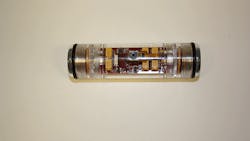Engineers at the Pacific Northwest National Laboratory (PNNL) have designed and built a robotic fish called the “Sensor Fish” that measures the hydrodynamic stresses water around dams put on migrating fish.
Back in the late 1990s, a 6-inch-long rubber fish powered by two AA batteries and basic circuitry proved not enough to document all the stresses involved in a fish’s journey through a dam. These early designs were expensive, costing $5,000 per Sensor Fish.
Researchers are updating the Sensor Fish to expand its uses and reduce the cost. The latest, second-generation version reduced the cost to $1,200 and can measure acceleration up to 200 gs more accurately and register twice as much pressure (174 psi). Engineers added more sensors to measure changes in the angular rate of change and linear acceleration during passage. They also added sensors for temperature capable of measuring -40 to 260° F, orientation, and a radio transmitter. A new retrieval system makes the device float after a set period of time. The device collects data at a 2,000-Hz sampling frequency and stores approximately five minutes of data with flash memory. Data can be downloaded through an external infrared link modem.
The AA batteries have been replaced with a 3.7-v lithium-ion rechargeable pack. This is also housed in a stronger polycarbonate shell. Most importantly, the first generation was only designed for large dams. With small hydroelectric dams now more common, this new design will work on both.
